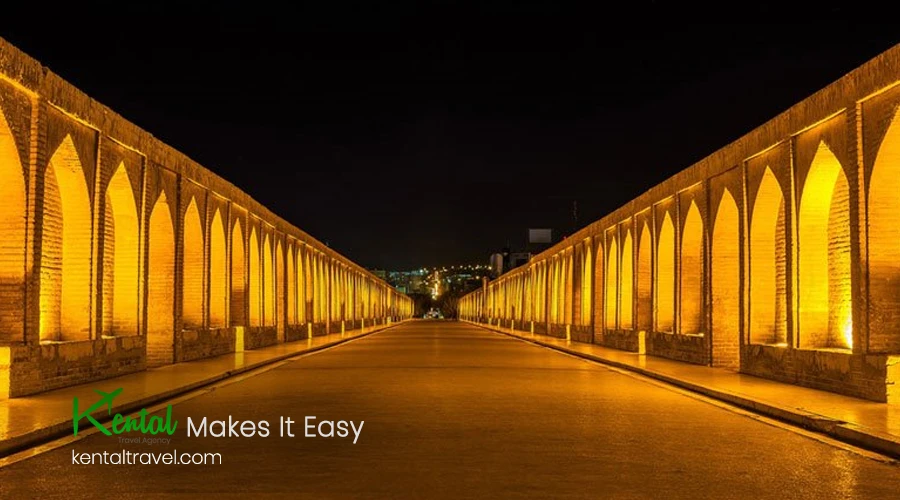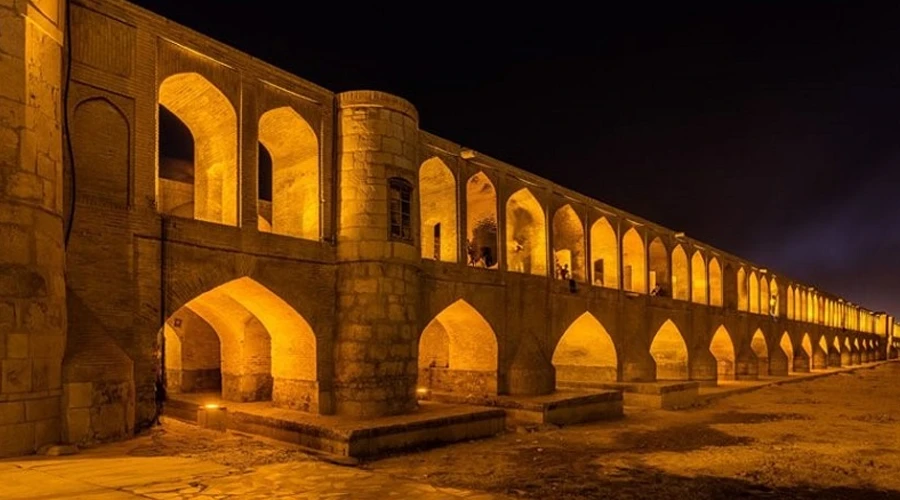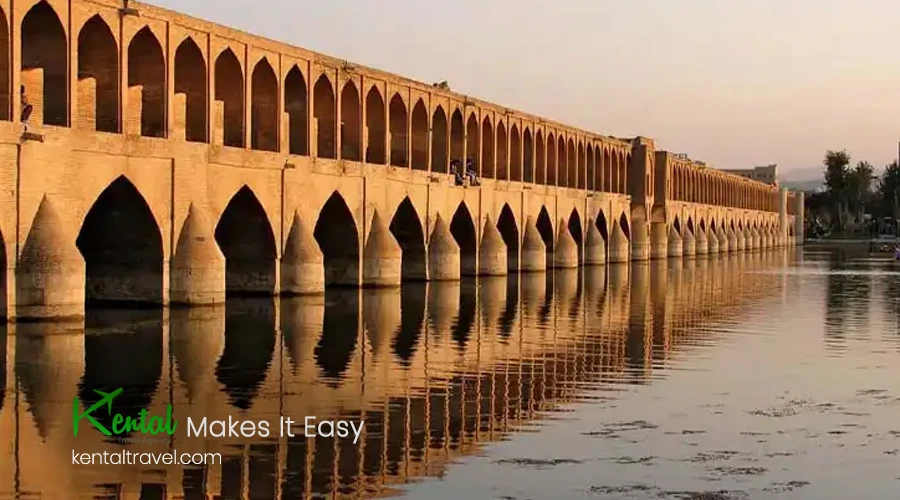Si-o-se Pol Bridge: A Complete Guide to the Historical Masterpiece of Isfahan

If we want to describe Isfahan with a symbol, undoubtedly, the Thirty-Three Bridges takes the top spot on the list. The Thirty-Three Bridges, also known as Si O Se Pol or Allahverdi Khan Bridge, is a two-story stone arch bridge that spans nearly 300 meters. It’s one of eleven bridges in Isfahan that crosses the Zayandeh Rud River. The Si-o-se-pol Bridge is the most famous in Isfahan due to its size, central location, and impressive architecture. This bridge serves as the central hub for nightly city entertainment, attracting Iranians and foreign tourists. Stay with us to learn more about this bridge, its history, and its attractions.
Where is Si O Se Pol Bridge Located?

Si-o-Se-Pol Bridge is located at the starting point of the southern side of Chahar Bagh Street on one side and the beginning of the northern side of Abbasi Chahar Bagh Street (Enqelab Square) on the other side. You can reach it by using your car or public transportation. The Si-o-Se-Pol metro station is just a few steps from the bridge. Additionally, the Enqelab Square bus station is on the other side of the bridge. If you’re driving your car, consider the local traffic during busy hours.
How To Get Iran Visa: Request Iran Visa
The Fascinating History of Si O Se Pol Bridge: From Safavid Era to Today
This bridge dates back to the Safavid era and the reign of Shah Abbas I, a time when Isfahan was the country’s capital. The bridge’s construction began in 1599 during Shah Abbas’s reign and was completed in 1602. This bridge spans the Zayandeh Rud River. Typically, bridges are built at narrower points in rivers, but this bridge was constructed at the widest point of the Zayandeh Rud River and is the longest bridge in Isfahan.
The name “Si-o-Seh Pol” indicates 33 arches and main columns. Initially, it had 40 arches, but some have gradually been abandoned. This bridge is known as “Pol-e Jolfa” and “Pol-e Abbasi. The old tales say It’s famous for being built using white egg-based mortar, contributing to its strength. Additionally, some studies have suggested that the bridge’s columns were designed to withstand immersion in water, as the drying of the Zayandeh Rud River could potentially damage its structural integrity.
Best Time to Visit Si-o-se Pol Bridge
Si-o-se Pol Bridge is a breathtaking historical landmark that offers a unique experience in every season. However, choosing the right time can enhance your visit significantly.
| Season | Weather Conditions | Reasons to Visit | Drawbacks |
|---|---|---|---|
| Spring (March – May) 🌸 | Pleasant and mild weather, full river flow | Beautiful nature, blooming trees, perfect for photography | Can be crowded during Nowruz holidays |
| Summer (June – August) ☀️ | Hot and dry weather, lower water levels | Lively nights, street performances, vibrant atmosphere | Extreme daytime heat, possible dry riverbed |
| Autumn (September – November) 🍂 | Cool and moderate temperatures, autumn foliage | Best time for photography, romantic ambiance | Occasional rainy days |
| Winter (December – February) ❄️ | Cold weather, chance of rain or snow | Quiet and peaceful setting, unique misty or snowy views | Chilly temperatures may be uncomfortable for some |
The architecture of Si-o-Se-Pol Bridge

The architecture of the Si o Se Pol Bridge is considered one of the world’s incredible architectural masterpieces. The architect of this historic structure was Hossein Esfahani, whose son, Mohammad Reza Esfahani, followed in his father’s footsteps and created the Sheikh Lotfollah Mosque.
This bridge, with a length of around 360 meters and a width of 14 meters, was built with 40 arches. One of the first things that stands out in the architecture of this bridge is its durability over time, thanks to the materials used in its construction. The bridge’s foundations are made of Sarooj (a traditional mortar mix), while the upper level is constructed with bricks and plaster. Sarooj is an architectural innovation of Iran, consisting of a blend of lime, clay, ashes, and fibers.
This masterpiece is a two-story structure, and both levels were used for the passage of people. Even caravans, vehicles, and heavy machinery used to pass on the upper level, but later, it was restricted to only pedestrian traffic to prevent damage to the bridge’s structure.
Si-o-se Pol at Night: A Mesmerizing Sight 🌙

As the sun sets, Si-o-se Pol Bridge unveils a new kind of beauty, transforming into one of Isfahan’s most enchanting nighttime attractions. The golden glow of its carefully designed illumination highlights the intricate details of its Safavid-era architecture, casting a warm and inviting ambiance.
If the Zayandeh River is flowing, the shimmering reflection of the bridge on the water creates a breathtaking view, making it a perfect spot for photography and quiet contemplation. The soft sounds of street musicians, the laughter of visitors, and the gentle murmur of the water add to the magical experience.
Whether you’re strolling across the bridge, sitting by the riverside, or enjoying a cup of tea at a nearby café, Si-o-se Pol at night offers a unique and unforgettable experience, blending history, romance, and culture under the starry Isfahan sky. ✨
What materials were used to build the Si-O-Se-Pol Bridge?
Three main materials were used in the bridge’s construction: stone for the lower parts, bricks, mortar, and plaster for the upper sections. Another crucial component of this bridge with unique adhesive properties is Sarouj. Sarouj is one of the ancient innovations of Iranian architects and was used to construct the Si-O-Se-Pol Bridge. It’s made from clay, limestone, ashes, and organic materials like egg whites. It becomes even stronger when it absorbs water. According to experts from the Department of Geology and Cultural Heritage, the foundation and base of the bridge were made with this material to increase its moisture resistance, durability, and structural integrity. This is why it can withstand long-term exposure to water without getting damaged.
Si-o-se Pol in Persian Literature & Art 🎨📖
Si-o-se Pol, or the 33-Arch Bridge, is not only a stunning piece of architectural history but also a significant cultural symbol in Persian literature and art. Its timeless beauty and historical importance have inspired countless works in these fields. Let’s explore how this iconic bridge has influenced Persian poets, artists, and literary works throughout the centuries.
In Persian Literature 📚
In Persian poetry, Si-o-se Pol has been a symbol of love, passage, and the connection between different worlds. Many poets, especially those from the Safavid era, have referenced the bridge in their verses, drawing upon its elegant structure to express deeper philosophical meanings. The bridge itself is often depicted as a metaphor for bridging the gap between life and death, the earthly and the spiritual, or the past and the future.
- Rumi and other classical Persian poets, though not directly referencing Si-o-se Pol, often wrote about bridges in a symbolic sense, exploring the idea of transcendence and unity.
- Contemporary poets in Isfahan also pay homage to Si-o-se Pol in their works, describing the bridge as a place where lovers meet, where history is witnessed, and where the flowing Zayandeh River represents the flow of time.
In Persian Art 🖌️
The majestic Si-o-se Pol has captured the imagination of many Persian artists throughout history. Its archways, reflections in the water, and harmonious design make it an ideal subject for paintings, murals, and calligraphy.
- Persian Miniature Paintings:
Artists of the Safavid period, known for their miniature paintings, often depicted architectural marvels like Si-o-se Pol in their works. The bridge’s elegant arches and symmetry were incorporated into the backdrop of grandiose scenes of royal life or battlefields, symbolizing the connection between the earthly realm and the divine. - Modern Persian Art:
In more recent Iranian art, Si-o-se Pol continues to inspire artists who use its image to explore themes of nostalgia, identity, and cultural heritage. Paintings often capture the bridge in different lights, from dawn to dusk, symbolizing the passage of time and the continuity of Persian culture. - Photography:
Today, Si-o-se Pol is a popular subject for photographers, both in Iran and internationally. The reflections of the bridge in the Zayandeh River and the vibrant nighttime illuminations have become iconic in visual depictions of Isfahan.
Cultural Symbolism 🌍
In both literature and art, Si-o-se Pol has come to represent a cultural bridge, uniting the past with the present. It’s not just an architectural feat, but a symbol of national pride, cultural continuity, and the rich artistic and literary heritage of Persian civilization.
Whether in literary verses, paintings, or modern photography, Si-o-se Pol remains an enduring symbol of Isfahan’s cultural identity, continuing to inspire generations of poets and artists. Its arches and reflections evoke a sense of continuity and beauty that transcends time, making it one of the most cherished landmarks in Persian history and art.
Nearby Attractions to Visit After Exploring Si O Se Pol

In the distant past, this bridge hosted grand ceremonies. For instance, during the Safavid era, it was customary to celebrate Nowruz (the Persian New Year) and the arrival of spring for up to seven consecutive nights. People would gather at this location and scatter flowers on the path of Shah Abbas and his entourage; this ceremony was known as “Golrizan.”
Another old-time ceremony on this bridge was called “Abpashan” or “Water Pouring.” It took place every July. During this event, even the king, nobles, scholars, and poets of the time would gather alongside the common people at this spot. The custom involved people sprinkling water and rosewater on each other, creating a joyful atmosphere. This day coincided with the “Tirgan” festival, making it a splendid and happy occasion for Iranians.
Another ceremony observed on this bridge was “Khaj Shuyan.” This ritual, commemorating the baptism of Jesus Christ, was traditionally held by the Armenians of Isfahan in the month of Dey, alongside other festivities.
See more: Isfahan Travel Guide
Things to Do at Si O Se Pol: From Photography to Walking
The unique location of Si-o-Se Pol, coupled with its extraordinary architecture, has made it one of the most famous and foremost tourist attractions in Isfahan. The recreational activities you can enjoy at this bridge include:
- Photography: Without a doubt, Si-o-Se Pol is one of the best and most beautiful subjects for photographers. Capturing memorable images of this astonishing architecture is one of the most intriguing things tourists do.
- Strolling: Another enjoyable and wholesome activity is walking along the streets leading to Si-o-Se Pol or on the bridge. Walking beside this special structure, especially at night, is an unparalleled tourist experience.
- Boating: The presence of the Zayandeh Rud River has made boating in this river and enjoying a different perspective of Si-o-Se Pol one of the most popular tourist activities.
Hotels and Restaurants Near Si-o-se Pol
When visiting Si-o-se Pol, there are plenty of options for both accommodations and dining nearby, making it easy for tourists to enjoy a comfortable and memorable stay. Here are some of the top hotels and restaurants around the iconic bridge:
Hotels Near Si-o-se Pol
- Kowsar Hotel
- Distance: About 5 minutes by car from Si-o-se Pol
- Description: A 4-star hotel offering a blend of traditional Iranian and modern comforts. With spacious rooms and excellent facilities, it’s a popular choice for both business and leisure travelers.
- Features: Swimming pool, fitness center, conference rooms, and restaurants.
- Abbasi Hotel Isfahan
- Distance: Around 10 minutes by car
- Description: This historic hotel, located in a beautiful 17th-century caravanserai, provides an authentic cultural experience. It’s one of the most luxurious and iconic hotels in Isfahan.
- Features: Traditional Iranian architecture, Persian gardens, pool, and exquisite dining options.
- Parsian Kowsar Hotel
- Distance: 5 minutes by taxi
- Description: A well-known 5-star hotel offering upscale rooms and excellent service. Its central location makes it perfect for tourists wanting to explore the city.
- Features: Restaurants, spa, and modern amenities.
- Eram Hotel
- Distance: 15 minutes by car
- Description: A highly rated hotel with a great location in the center of Isfahan. Comfortable rooms with great views, especially from upper floors.
- Features: Restaurant, business facilities, and close proximity to historical attractions.
Restaurants Near Si-o-se Pol
- Shahrzad Restaurant
- Distance: A short walk from Si-o-se Pol
- Cuisine: Traditional Persian
- Description: A famous restaurant known for its elegant atmosphere and high-quality Persian dishes. The restaurant’s interior reflects traditional Iranian design, adding to the authentic experience.
- Must-Try: Kebab, Fesenjan, and saffron ice cream.
- Gavazn Restaurant
- Distance: 10-minute walk
- Cuisine: Persian, with a focus on Isfahan specialties
- Description: Located close to Si-o-se Pol, this restaurant offers a relaxing dining experience with a variety of local dishes.
- Must-Try: Biryani Isfahan, a local specialty, and fresh herb stews.
- Royal Star Restaurant
- Distance: 5-10 minutes by car
- Cuisine: Persian, Middle Eastern, and international dishes
- Description: A more modern option with a stylish atmosphere. It’s an excellent place for both tourists and locals, offering a range of Iranian and international dishes.
- Must-Try: Persian kebabs, stews, and fresh juices.
- Kooh-e Noor Café & Restaurant
- Distance: 15 minutes by walk
- Cuisine: Persian and International
- Description: A charming spot for those who want to enjoy a peaceful meal with great views. Its setting is cozy and relaxed, ideal for a post-visit break.
- Must-Try: Persian-style grilled meats and traditional desserts like Faloodeh.
Whether you’re looking for a luxurious stay or an authentic Persian dining experience, the area around Si-o-se Pol has options for all tastes and budgets, making your visit even more enjoyable! 🌟
How to Get to Si-o-se Pol
| Mode of Transportation | Description |
|---|---|
| 🚖 Taxi & Ride-Hailing Apps | The easiest and quickest way to get to Si-o-se Pol. You can use apps like Snapp or Tapsi to book a ride and input “Si-o-se Pol” as your destination. |
| 🚍 Bus | Several bus lines go to stations near Si-o-se Pol, such as Enghelab Square and Chahar Bagh Avenue. From there, it’s a short walk to the bridge. |
| 🚇 Metro | The closest metro station is Takhti Station on Line 1. From there, you can either walk for about 15 minutes along Chahar Bagh Street or take a short taxi ride. |
| 🚗 Private Car | If driving, there are parking lots around Si-o-se Pol, such as those on Chahar Bagh Abbasi Street and Abshar Street, but parking can be difficult during peak times. |
📍 Location: Si-o-se Pol is located on Chahar Bagh Abbasi Street spanning the Zayandeh River in the heart of Isfahan.
FAQs about Si O Se Pol BridgeFAQs About Si O Se Pol Bridge
- How old is Si O Se Pol Bridge?
Si O Se Pol was built in 1602 AD during the reign of Shah Abbas I. The bridge was designed as a vital trade and military route, connecting both sides of the Zayandeh Rud River. With over 400 years of history, it remains one of Iran’s oldest and most significant bridges. - Is Si O Se Pol Bridge open to visitors?
Yes, Si O Se Pol is open to visitors at all times. It is not only a historical monument but also a popular tourist and social spot, where locals and tourists can walk, take photos, and enjoy the scenic views. The bridge is especially beautiful at night when illuminated by golden lights. - What is the best time to take photos at Si O Se Pol?
The best time for photography at Si O Se Pol is sunrise or sunset, as the soft natural light enhances the bridge’s architecture and its reflection in the Zayandeh Rud River. If you prefer night photography, visit after sunset when the bridge’s lighting creates a stunning visual effect. - Is there an entrance fee for Si O Se Pol?
No, Si O Se Pol is free to visit. There is no entrance fee, and visitors can explore the bridge at any time. However, some nearby attractions, such as guided tours or historical sites, may have a separate charge. You can also enjoy the cafés and restaurants around the bridge. - What are the opening hours of Si O Se Pol?
Si O Se Pol is open 24/7. However, for a better experience, visitors are advised to go early in the morning or late at night to avoid crowds and enjoy the peaceful atmosphere. - What activities can you do at Si O Se Pol?
Visitors to Si O Se Pol can enjoy various activities, such as:- Walking along the bridge and riverside
- Photography of the historic architecture and reflections in the river
- Relaxing on the banks of the Zayandeh Rud River
- Experiencing the night view with stunning light displays
- Exploring the nearby markets for souvenirs and local crafts
- Is Si O Se Pol accessible for people with disabilities?
While Si O Se Pol is open to all visitors, its historical design may make accessibility difficult in some areas. However, there are walking paths and seating areas around the bridge, making it accessible to most visitors.
The editorial department of Kental Travel prepared this article, and its non-commercial use is unchecked by the mention of the source. To check out more articles related to traveling to Iran, you can visit the Kental Travel blog.
